偏误分析与对比分析(全)
- 格式:ppt
- 大小:360.00 KB
- 文档页数:68
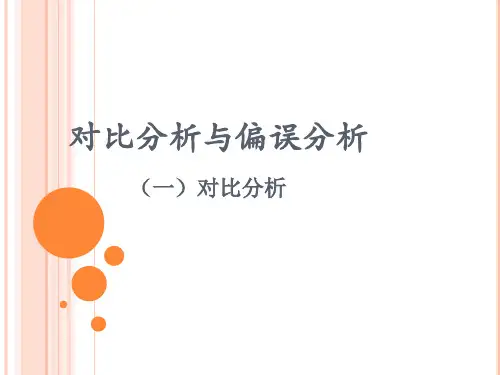
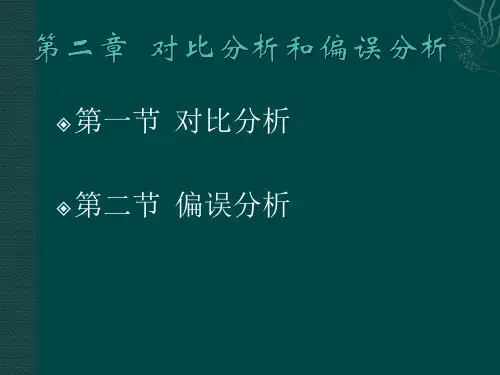
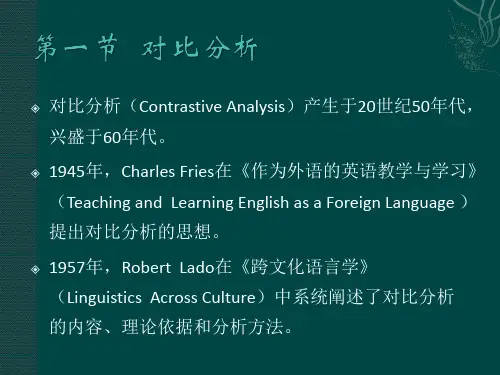
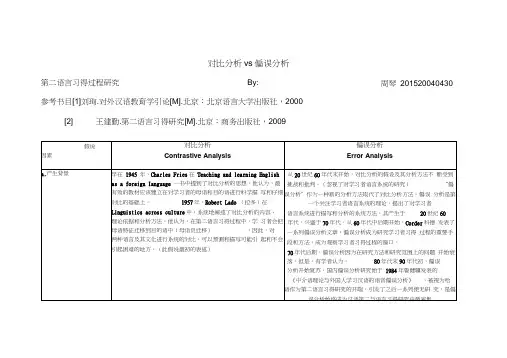
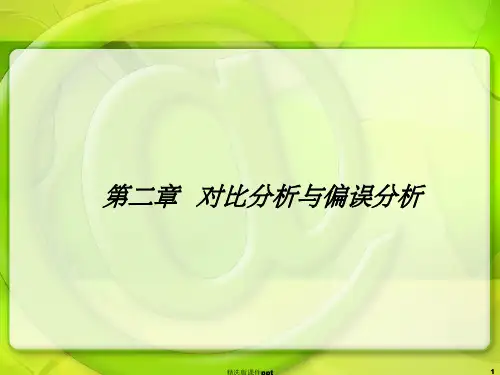
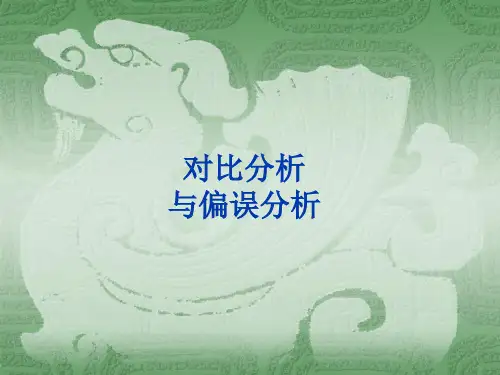


第二章对比分析与偏误分析第一节对比分析假设“对比分析”产生并流行于20世纪50年代。
60年代是对比分析的兴盛时期。
美国和欧洲的一些国家建立了语言对比研究中心。
60年代后期,由于认知心理学和转换生成语法的出现,其理论基础受到挑战,对比分析开始衰落。
F r i e s(1945)率先提出了最有效的教材应该建立在对学习者的母语和目的语进行科学的描写和仔细的对比的基础上。
体现在他的著作:“T e a c h i n g a n d L e a r n i n g E n g l i s h a s a F o r e i g n L a n g u a g e”。
L a d o(1957)提出对比分析理论系统。
标志著作“l i n g u i s i t i c s a c r o s s c u l t u r e”。
L a d o(1957):“W e c a n p r e d i c t a n d d e s c r i b e t h e p a t t e r n s t h a t w i l l c a u s e d i f f i c u l t yi n l e a r n i n g,a n d t h o s e t h a t w i l l n o t c a u s e d i f f i c u l t y,b y c o m p a r i n gs y s t e m a t i c a l l y t h e l a n g u a g e a n d t h e c u l t u r e t o b e l e a r n e d w i t h t h e n a t i v el a n g u a g e a n d c u l t u r e o f t h e s t u d e n t.”L a d o认为,通过学习者母语、文化与其目的语、文化系统对比,可以预测造成学习者困难的语言模式。
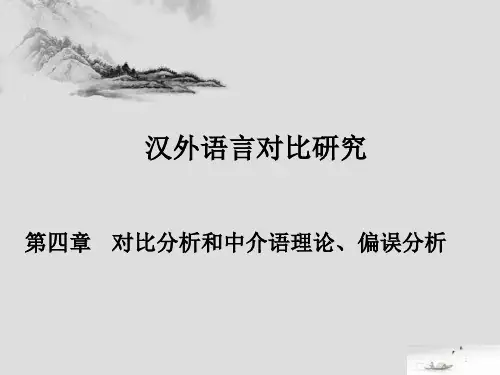
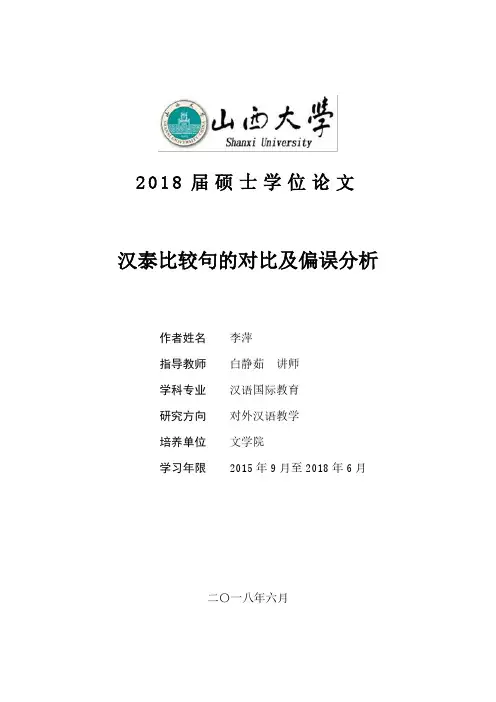
2018届硕士学位论文汉泰比较句的对比及偏误分析作者姓名李萍指导教师白静茹讲师学科专业汉语国际教育研究方向对外汉语教学培养单位文学院学习年限 2015年9月至2018年6月二〇一八年六月山西大学2018届硕士学位论文汉泰比较句的对比及偏误分析作者姓名李萍指导教师白静茹讲师学科专业汉语国际教育研究方向对外汉语教学培养单位文学院学习年限 2015年9月至2018年6月二〇一八年六月Thesis for Master’ s degree, Shanxi University, 2018Comparative Study and Error Analysis for ComparativeSentence of Chinese and ThaiStudent Name Ping LiSupervisor Lecturer Jing–ru BaiMajor Master of Teaching Chinese toSpeakers of Other LanguagesSpecialty Teaching Chinese as a ForeignLanguageDepartment Department of LiteratureResearch Duration 2015.09-2018.06June, 2018目录中文摘要 (I)ABSTRACT.............................................................................................................................................................................. I I 第一章绪论.. (1)1.1研究背景和意义 (1)1.2研究现状和成果 (1)1.2.1比较句的本体研究 (2)1.2.2比较句的对外汉语教学研究 (4)1.3研究思路和方法 (6)第二章汉泰“比较句”的对比分析 (7)2.1汉泰语言概况 (7)2.2汉泰差比句对比分析 (9)2.2.1“比”字句 (9)2.2.2“不如”、“没有”句 (13)2.2.3“不比”句 (14)2.3汉泰等比句对比研究 (15)2.3.1“跟......一样”句.. (15)2.3.2“A有B那么(这么)......”句 (16)第三章泰国学习者习得汉语比较句的偏误分析 (17)3.1偏误分析 (17)3.2偏误类型 (17)3.2.1比较值 (18)3.2.2比较项不对称 (20)3.2.3程度副词误用 (21)3.2.4否定词位置错误 (21)3.2.5比较标记误用 (22)3.3偏误成因 (23)第四章汉语比较句的教学启示 (25)4.1汉语教材中比较句的分析 (25)4.1.1《汉语教程》 (25)4.1.2《会通汉语》 (27)4.1.3《汉语教程》和《会通汉语》的比较 (29)4.2对教材编写和课堂教学的建议 (30)4.2.1对教材编写的建议 (30)4.2.2对课堂教学的启示 (31)4.3“比”字句的教学设计 (32)结语 (37)参考文献 (39)附录 (41)攻读学位期间取得的研究成果 (49)致谢 (51)个人简况及联系方式 (53)承诺书 (55)学位论文使用授权声明 (57)ContentsChinese abstract (I)ABSTRACT (II)Chapter 1 Intruduction (1)1.1 Research background and significance (1)1.2 Research status and achievements (1)1.2.1 The study of the noumenon of comparative sentences (2)1.2.2 The study of teaching Chinese in comparative sentences (4)1.3 Research ideas and methods (6)Chapter 2 Comparative analysis for Chinese and Thai (7)2.1 Overview of Chinese and Thai (7)2.2 Comparative analysis of comparative sentences (9)2.2.1“比”sentences (9)2.2.2“不如”、“没有”sentences (13)2.2.3“不比”sentences (14)2.3 Comparative analysis of equivalent sentences (15)2.3.1“跟...一样”sentences. (15)2.3.2“A有B那么(这么)...”sentences (16)Chapter 3 The error analysis (17)3.1 Error analysis (17)3.2 Types of errors (17)3.2.1 Comparative value (18)3.2.2 Comparison item asymmetry (20)3.2.3 Misuse of degree adverbs (21)3.2.4 Position error negative word (21)3.2.5 Misuse of comparison marks (22)3.3 Causes of errors (23)Chapter 4 Teaching enlightenment (25)4.1 Comparative sentences in Chinese textbooks (25)4.1.1 HANYUJIAOCHENG (25)4.1.2 Mastering Chinese (27)4.1.3 The comparison of HANYUJIAOCHENG and Mastering Chinese (29)4.2 Suggestions (30)4.2.1 Suggestions for the teaching materials (30)4.2.2 Suggestions for classroom teaching (31)4.3 Teaching design of “比” sentences (32)Conclusion (37)References (39)Appendix (41)Research achievements (49)Acknowledgement (51)Personal profiles (53)Letter of commitment (55)Authorization statement (57)中文摘要汉语比较句是现代汉语的常用句式之一,是对外汉语教学的一个重要内容,也是泰国学习者应该掌握的语法点之一。
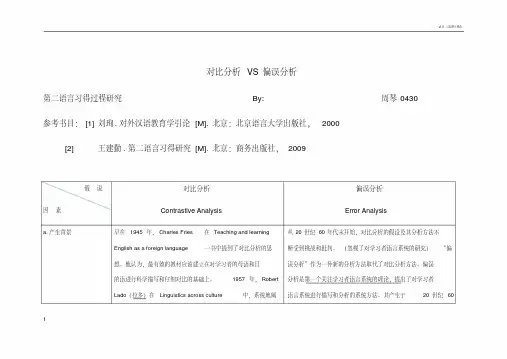
对比分析VS偏误分析第二语言习得过程研究 By:周琴 0430参考书目:[1]刘珣.对外汉语教育学引论[M].北京:北京语言大学出版社,2000[2]王建勤.第二语言习得研究[M].北京:商务出版社,2009假说因素对比分析Contrastive Analysis偏误分析Error Analysisa.产生背景早在1945年,Charles Fries在Teaching and learningEnglish as a foreign language一书中提到了对比分析的思想。
他认为,最有效的教材应该建立在对学习者的母语和目的语进行科学描写和仔细对比的基础上。
1957年,RobertLado(拉多)在Linguistics across culture中,系统地阐从20世纪60年代末开始,对比分析的假设及其分析方法不断受到挑战和批判。
(忽视了对学习者语言系统的研究)“偏误分析”作为一种新的分析方法取代了对比分析方法。
偏误分析是第一个关注学习者语言系统的理论,提出了对学习者语言系统进行描写和分析的系统方法。
其产生于20世纪601述了对比分析的内容、理论依据和分析方法。
他认为,在第二语言习得过程中,学习者会把母语特征迁移到目的语中(母语负迁移),因此,对两种语言及其文化进行系统的对比,可以预测和描写可能引起和不会引起困难的地方。
(此假说最初的表述)年代,兴盛于70年代。
从60年代中后期开始,Corder科德发表了一系列偏误分析文章,偏误分析成为研究学习者习得过程的重要手段和方法,成为观察学习者习得过程的窗口。
70年代后期,偏误分析因为在研究方法和研究范围上的问题开始衰落。
但是,有学者认为,80年代末90年代初,偏误分析开始复苏。
国内偏误分析研究始于1984年鲁健骥发表的《中介语理论与外国人学习汉语的语音偏误分析》,被视为哈语作为第二语言习得研究的开端。
引发了之后一系列便无研究,是偏误分析始终成为汉语第二与语言习得研究中最密集的研究领域。
汉德语言对比及偏误分析摘要:本文将汉语与德语进行对比,从语音、词汇和语法三方面入手,并对留学生学习汉语的偏误进行分析,找出其偏误的原因和规律,以期在今后的教学中能有所帮助。
关键字:汉语德语语言对比偏误分析第一,汉德语音对比和偏误分析。
汉语、德语中都存在元音音位和辅音音位,这是两种语言中最基本的音位"它们组成语言中的基础音位,通过音质的不同起到区别意义的作用,所以辅音音位和元音音位统称为音质音位.如ӧ和eu 是德语中特有的元音音位,汉语中没有.汉语中的i在z,c,s,j,q,x,zh,ch,sh,r 之后组成的语素中构成i独特的音位.在辅音音位方面,汉德两种语言相同的辅音音位少,不同的较多。
语言中最基本的语音结构单位是音节,一个音节可能只有一个音位构成,但更多的音节是由两个以上的音位构成的"汉语中在有辅音音位的音节里,辅音音位多半都出现在开头,收尾的辅音音位只限于鼻辅音音位/n/和/ƞ/,而且不可能出现两个辅音音位连续排列的现象.在德语的音节中几乎找不到三个元音连续排列在一起的现象,最多只有两个元音排列在一起,这就是复合元音,辅音音位多半出现在开头,但收尾的辅音音位也很多,而且不限于鼻辅音音位。
在德语音节中两个辅音音位连续排列的现象可谓俯拾皆是,没有连续排列三个元音音位的音节,但有三个辅音音位连续排列的现象。
汉语中的非音质音位最突出的表现是四声,几乎每一个元音音位都可能有“四声”,从而区别意义。
德语中没有四声,但是构成音节的元音却有长短音之分,长音和短音也有区别词义的作用,在两个音节以上的德语词语中必有一个音节的元音音位是重读的,这就是词重音。
两个音节相同的词因为词重音的不同构成了词义的差别。
1、汉语有,而德语没有的辅音。
汉语辅音中的送气音p〔p'〕、t[t']、k【k'〕,在德语中没有,这是德国学生学习汉语辅音的难点之一。
德国学生面对送气音p[P']、t[t']、k〔r」的时候,常常会犯错,把送气音发成不送气音;在面对不送气音b[P]、d[t]、g[k」时,会按照德语发音的习惯,发成浊音[b][d][g]。